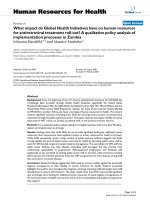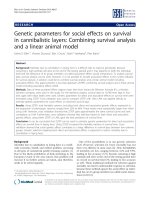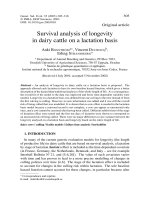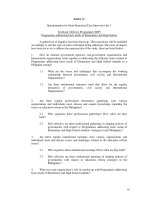Survival analysis intuition implementation in python
Bạn đang xem bản rút gọn của tài liệu. Xem và tải ngay bản đầy đủ của tài liệu tại đây (717.32 KB, 19 trang )
Survival Analysis: Intuition &
Implementation in Python
Anurag Pandey
Jan 6 · 15 min read
T
here is a statistical technique which can answer business questions as
follows:
How long will a particular customer remain with your business? In other
words, after how much time this customer will churn?
How long will this machine last, after successfully running for a year ?
What is the relative retention rate of different marketing channels?
What is the likelihood that a patient will survive, after being diagnosed?
If you find any of the above questions (or even the questions remotely related to
them) interesting then read on.
The purpose of this article is to build an intuition, so that we can apply this
technique in different business settings.
. . .
Table of Contents
1. Introduction
2. Definitions
3. Mathematical Intuition
4. Kaplan-Meier Estimate
5. Cox Proportional Hazard Model
6. End Note
7. Additional Resources
Introduction
Survival Analysis is a set of statistical tools, which addresses questions such as
‘how long would it be, before a particular event occurs’; in other words we can
also call it as a ‘time to event’ analysis. This technique is called survival analysis
because this method was primarily developed by medical researchers and they
were more interested in finding expected lifetime of patients in different
cohorts (ex: Cohort 1- treated with Drug A, & Cohort 2- treated with Drug B).
This analysis can be further applied to not just traditional death events, but to
many different types of events of interest in different business domains. We will
discuss more on the definition of events and time to events in the next section.
Definitions
As mentioned above that the Survival Analysis is also known as Time to Event
analysis. Thus, from the name itself, it is evident that the definition of Event of
interest and the Time is vital for the Survival Analysis. In order to understand
the definition of time and event, we will define the time and event for various
use cases in industry.
1. Predictive Maintenance in Mechanical Operations: Survival Analysis
applies to mechanical parts/ machines to answer about ‘how long will the
machine last?’. Predictive Maintenance is one of its applications. Here,
Event is defined as the time at which the machine breaks down. Time of origin
is defined as the time of start of machine for the continuous operations. Along
with the definition of time we should also define time scale (time scale
could be weeks, days, hours..). The difference between the time of event
and the time origin gives us the time to event.
2. Customer Analytics (Customer Retention): With the help of Survival
Analysis we can focus on churn prevention efforts of high-value customers
with low survival time. This analysis also helps us to calculate Customer Life
Time Value. In this use case, Event is defined as the time at which the
customer churns / unsubscribe. Time of origin is defined as the time at which
the customer starts the service/subscription with a company. Time scale
could be months, or weeks. The difference between the time of event and
the time origin gives us the time to event.
3. Marketing Analytics (Cohort Analysis): Survival Analysis evaluates the
retention rates of each marketing channel. In this use case, Event is defined
as the time at which the customer unsubscribe a marketing channel. Time of
origin is defined as the time at which the customer starts the service /
subscription of a marketing channel. Time scale could be months, or weeks.
4. Actuaries: Given the risks of a population, survival analysis evaluates the
probability of the population to die in a particular time range. This analysis
helps the insurance companies to evaluate the insurance premiums. Guess,
the event and time definition for this use case!!!
I hope the definition of a event, time origin, and time to event is clear from the
above discussion. Now its time to delve a bit deeper into the mathematical
formulation of the analysis.
Mathematical Intuition
Lets assume a non-negative continuous random variable T, representing the
time until some event of interest. For example, T might denote:
• the time from the customer’s subscription to the customer churn.
• the time from start of a machine to its breakdown.
• the time from diagnosis of a disease until death.
Since we have assumed a random variable T (a random variable is generally
represented in capital letter), so we should also talk about some of its attributes.
T is a random variable, ‘what is random here ?’. To understand this we will
again use our earlier examples as follows.
• T is the time from customer’s(a randomly selected customer) subscription to
the customer churn.
• T is the time from start of a randomly selected machine to its breakdown.
• T is the time from diagnosis of a disease until death of a randomly selected
patient.
T is continuous random variable, therefore it can take any real value. T is nonnegative, therefore it can only take positive real values (0 included).
For such random variables, probability density function (pdf) and
cumulative distribution function (cdf) are commonly used to characterize
their distribution.
Thus, we will assume that this random variable has a probability density
function f(t) , and cumulative distribution function F(t) .
pdf : f(t)
cdf : F(t) : As per the definition of cdf from a given pdf, we can define cdf as
F(t) = P (T< t) ; here , F(t) gives us the probability that the event has occurred
by duration t. In simple words, F(t) gives us the proportion of population with
the time to event value less than t.
cdf as the integral form of pdf
Survival Function: S(t) = 1 - F(t)= P(T ≥t); S(t) gives us the probability that
the event has not occurred by the time t . In simple words, S(t) gives us the
proportion of population with the time to event value more than t.
Survival Function in integral form of pdf
Hazard Function : h(t) : Along with the survival function, we are also
interested in the rate at which event is taking place, out of the surviving
population at any given time t. In medical terms, we can define it as “out of the
people who survived at time t, what is the rate of dying of those people”.
Lets make it even more simpler:
1. Lets write it in the form of its definition:
h(t) = [( S(t) -S(t + dt) )/dt] / S(t)
limit dt → 0
2. From its formulation above we can see that it has two parts. Lets understand
each part
Instantaneous rate of event: ( S(t) -S(t + dt) )/dt ; this can also be seen as the
slope at any point t of the Survival Curve, or the rate of dying at any time t.
Also lets assume the total population as P.
Here, S(t) -S(t + dt) , this difference gives proportion of people died in time dt,
out of the people who survived at time t. Number of people surviving at t is
S(t)*P and the number of people surviving at t+dt is S(t+dt)*P. Number of
people died during dt is (S(t) -S(t + dt))*P. Instantaneous rate of people dying
at time t is (S(t) -S(t + dt))*P/dt.
Proportion Surviving at time t: S(t); We also know the surviving population at
time t, S(t)*P.
Thus dividing number of people died in time dt, by the number of people
survived at any time t, gives us the hazard function as measure of RISK of the
people dying, which survived at the time t.
The hazard function is not a density or a probability. However, we can think of it
as the probability of failure in an infinitesimally small time period between (t)
and (t+ dt) given that the subject has survived up till time t. In this sense, the
hazard is a measure of risk: the greater the hazard between times t1 and
t2, the greater the risk of failure in this time interval.
We have : h(t) = f(t)/S(t) ; [Since we know that ( S(t) -S(t + dt) )/dt = f(t)]
This is a very important derivation. The beauty of this function is that Survival
function can be derived from Hazard function and vice versa. The utility of this
will be more evident while deriving a survival function from a given hazard
function in Cox Proportional Model (Last segment of the article).
These were the most important mathematical definitions and the formulations
required to understand the survival analysis. We will end our mathematical
formulation here and move forward towards estimation of survival curve.
Kaplan-Meier Estimate
In the Mathematical formulation above we assumed the pdf function and
thereby derived Survival function from the assumed pdf function. Since we
don’t have the true survival curve of the population, thus we will estimate the
survival curve from the data.
There are two main methods to estimate the survival curve. The first method is
a parametric approach. This method assumes a parametric model, which is
based on certain distribution such as exponential distribution, then we estimate
the parameter, and then finally form the estimator of the survival function. A
second approach is a powerful non-parametric method called the KaplanMeier estimator. We will discuss it in this section. In this section we will also
try to create the Kaplan-Meier curve manually as well as by using the Python
library (lifelines).
Here, ni is defined as the population at risk at time just prior to time ti; and di is
defined as number of events occurred at time ti. This, will become more clear
with the example below.
We will discuss an arbitrary example from a very small self created data, to
understand the creation of Kaplan Meier Estimate curve, manually as well as
using a python package.
Event, Time and Time Scale Definition for the Example:
The example below(Refer Fig 1) shows the data of 6 users of a website. These
users visit the website and leaves that website after few minutes. Thus, event of
interest is the time in which a user leaves the website. Time of origin is defined
as the time of opening the website by a user and the time scale is in minutes.
The study starts at time t=0 and ends at time t=6 minutes.
Censorship:
Point worth noting here is that during the study period , event happened with 4
out of 6 users(shown in red), while two users (shown in green) continued and
the event didn’t happened till the end of the study; such data is called the
Censored data.
In case of censorship, as here in case of user 4 and user 5, we don’t know at
what time the event will occur, but still we are using that data to estimate the
probability of survival. If we choose not to include the censored data, then it is
highly likely that our estimates would be highly biased and under-estimated.
The inclusion of censored data to calculate the estimates, makes the Survival
Analysis very powerful, and it stands out as compared to many other statistical
techniques.
Calculations for KM Curve and the interpretation:
Now, lets talk about the calculations done to create the KM Curve below (Refer
Fig 1). In figure 1, Kaplan Meier Estimate curve, x axis is the time of event and y
axis is the estimated survival probability.
From t=0 till t<2.5 or t∈[0 , 2.5), number of users at risk(ni) at time t=0 is 6
and number of events occurred(di) at time t=0 is 0, therefore for all t in this
interval, estimated S(t) = 1. From the definition of the event we can say that
100% is the probability that the time between a user opens the website and exit
the website is greater than 2.499* minutes.
From t=2.5 till t<2.4 or t ∈ [2.5 , 4), number of users at risk(ni) at time just
before time 2.5 minutes (2.4999* mins) is 6 and number of events occurred(di)
at time t=2.5 minutes is 1, therefore therefore for all t in this interval, estimated
S(t)= 0.83. From the definition of the event we can say that 83% is the
probability that the time between a user opens the website and exit the website
is greater than 3.999* minutes.
From t=4 till t<5 or t ∈[4 , 5), number of users at risk(ni) at time just before
time 4 minutes (3.999* mins) is 5 and number of events occurred(di) at time
t=4 minutes is 2, therefore for all t in this interval, estimated S(t) = 0.5. This
result can also be verified by simple mathematics of relative frequency. For any
t∈[4,5), lets say t=4.5, total number of users at the start were 6, total number
remaining at t are 3. Therefore, the probability of the users spending more than 4.5
(or any time t ∈[4,5)) minutes on website is (3/6), which is 50%.
Similarly, we can estimate the probability for other time intervals (refer table
calculations in fig 1)
Mathematically, for any time t ∈ [t1, t2), we have
S(t) = P(survive in [0, t1)) × P(survive in [t1, t] | survive in [0, t1))
g 1: a. Shows the user level time data in color.; b. Shows Kaplan Meier (KM)Estimate Curve; c.
Formula for estimation of KM curve; d. Table showing the calculations
# Python code to create the above Kaplan Meier curve
from lifelines import KaplanMeierFitter
## Example Data
durations = [5,6,6,2.5,4,4]
event_observed = [1, 0, 0, 1, 1, 1]
## create a kmf object
kmf = KaplanMeierFitter()
## Fit the data into the model
kmf.fit(durations, event_observed,label='Kaplan Meier
Estimate')
## Create an estimate
kmf.plot(ci_show=False) ## ci_show is meant for Confidence
interval, since our data set is too tiny, thus i am not
showing it.
Real World Example:
As mentioned earlier that Survival Analysis can be used for the cohort analysis,
to gain insights. So, here we will be using the Telco-Customer-Churn data set, to
gain insight about the lifelines of customers in different cohorts.
Github link for the code: Link
Lets create two cohorts of customers based on whether a customer has
subscribed for Streaming TV or not. We want to know that which cohort has the
better customer retention.
The required code for plotting the Survival Estimates is given below.
kmf1 = KaplanMeierFitter() ## instantiate the class to create
an object
## Two Cohorts are compared. Cohort 1. Streaming TV Not
Subscribed by users, and Cohort 2. Streaming TV subscribed
by the users.
groups = df['StreamingTV']
i1 = (groups == 'No')
## group i1 , having the pandas
series for the 1st cohort
i2 = (groups == 'Yes')
## group i2 , having the pandas
series
for the 2nd cohort
## fit the model for 1st cohort
kmf1.fit(T[i1], E[i1], label='Not Subscribed StreamingTV')
a1 = kmf1.plot()
## fit the model for 2nd cohort
kmf1.fit(T[i2], E[i2], label='Subscribed StreamingTV')
kmf1.plot(ax=a1)
Fig 2: Kaplan Meier Curve of the two cohorts.
We have two survival curves , one for each cohort. From the curves, it is evident
that the customers, who have subscribed for the Streaming TV, have better
customer retention as compared to the customers, who have not subscribed for
the Streaming TV. At any point t across the timeline, we can see that the
survival probability of the cohort in blue is less than the cohort in red. For the
cohort in blue, the survival probability is decreasing with high rate in first 10
months and it gets relatively better after that; however, for the red cohort, the
rate of decrease in survival rate is fairly constant. Therefore, for the cohort ,
which has not subscribed for the Streaming TV, efforts should be made to retain
the customers in first 10 volatile months.
We can do more such cohort analysis from the survival curves of the different
cohorts. This cohort analysis represents the limited use case of the potential of
the survival analysis because we are using it for the aggregated level of the data.
We can create the Survival Curves for even the individual users based on the
effects of covariates on the baseline Survival Curves. This will be our focal point
of the next section of this article.
Cox Proportional Hazard Model
The time to event for an individual in the population is very important for the
survival curves at the aggregate level; however, in real life situations along with
the event data we also have the covariates (features) of that individual. In such
cases, it is very important to know about the impact of covariates on the
survival curve. This would help us in predicting the survival probability of an
individual, if we know the associated covariates values.
For example, in the telco-churn example discussed above, we have each
customer’s tenure when they churned (the event time T) and the customer’s
Gender, MonthlyCharges, Dependants, Partner, PhoneService etc. The other
variables are the covariates in this example. We are often interested in how
these covariates impacts the survival probability function.
In such cases, it is the conditional survival function S(t|x) = P(T > t|x). Here x
denotes the covariates. In our example, we are interested in S(tenure > t|
(Gender, MonthlyCharges, Dependants, Partner, PhoneService etc)).
The Cox (proportional hazard) model is one of the most popular model
combining the covariates and the survival function. It starts with modeling the
hazard function.
Here, β is the vector of coefficients of each covariate. The function ho(t) is
called the baseline hazard function.
The Cox model assumes that the covariates have a linear multiplication effect on
the hazard function and the effect stays the same across time.
The idea behind the model is that the log-hazard of an individual is a
linear function of their static covariates, and a population-level baseline
hazard that changes over time. [Source: lifelines documentation]
From the above equation we can also derive cumulative conditional hazard
function as below:
As we are already aware that we can derive survival function from the hazard
function with the help of expression derived in above section. Thus, we can get
the survival function for each subject/individual/customer.
Basic implementation in python:
We will now discuss about its basic implementation in python with the help of
lifelines package. We have used the same telco-customer-churn data-set, which
we have been using in the above sections. We will run a python code for
predicting the survival function at customer level.
from lifelines import CoxPHFitter
## My objective here is to introduce you to the
implementation of the model.Thus taking subset of the columns
to train the model.
## Only using the subset of the columns present in the
original data
df_r= df.loc[:['tenure', 'Churn', 'gender', 'Partner',
'Dependents',
'PhoneService','MonthlyCharges','SeniorCitizen','StreamingTV'
]]
df_r.head() ## have a look at the data
## Create dummy variables
df_dummy = pd.get_dummies(df_r, drop_first=True)
df_dummy.head()
# Using Cox Proportional Hazards model
cph = CoxPHFitter()
## Instantiate the class to create a
cph object
cph.fit(df_dummy, 'tenure', event_col='Churn')
data to train the model
cph.print_summary()
the features
## Fit the
## HAve a look at the significance of
The summary statistics above indicates the significance of the covariates in
predicting the churn risk. Gender doesn’t play any significant role in predicting
the churn, whereas all the other covariates are significant.
Interesting point to note here is that , the β (coef ) values in case of covariates
MonthlyCharges and gender_Male is approximately zero (~-0.01), but still the
MonthlyCharges plays a significant role in predicting churn , while the latter is
insignificant. The reason is that the MonthlyCharges is continuous value and it can
vary from the order of tens, hundreds to thousands, when multiplied by the small
coef (β=-0.01), it becomes significant. On the other hand, the covariate gender can
only take the value 0 or 1, and in both the cases [exp(-0.01 * 0), exp(-0.01*1)] it
will be insignificant.
## We want to see the Survival curve at the customer level.
Therefore, we have selected 6 customers (rows 5 till 9).
tr_rows = df_dummy.iloc[5:10, 2:]
tr_rows
## Lets predict the survival curve for the selected
customers.
## Customers can be identified with the help of the number
mentioned against each curve.
cph.predict_survival_function(tr_rows).plot()
g 2. It shows the Survival Curves at customer level of customer number 5,6,7,8, and 9
Fig 2 . shows the survival curves at customer level. It shows the survival curves
for customer number 5,6,7,8, & 9.
Creating the survival curves at each customer level helps us in proactively
creating a tailor made strategy for high-valued customers for different survival
risk segments along the timeline.
End Note
Though, there are many other things which are still remaining to be covered in
survival analysis such as ‘checking proportionality assumption’, & ‘model
selection’ ; however, with a basic understanding of the mathematics behind the
analysis, and the basic implementation of the survival analysis (using the
lifelines package in python) will help us in implementing this model in any
pertinent business use case.
Additional Resources









